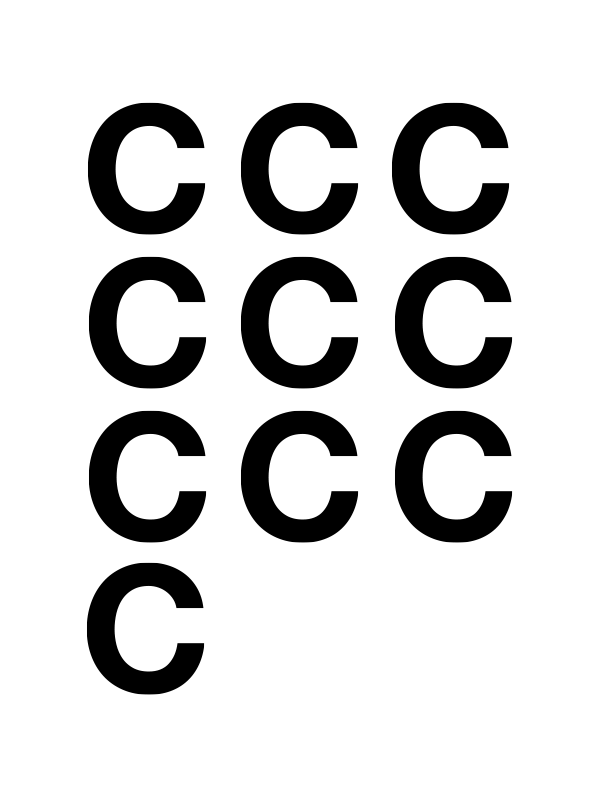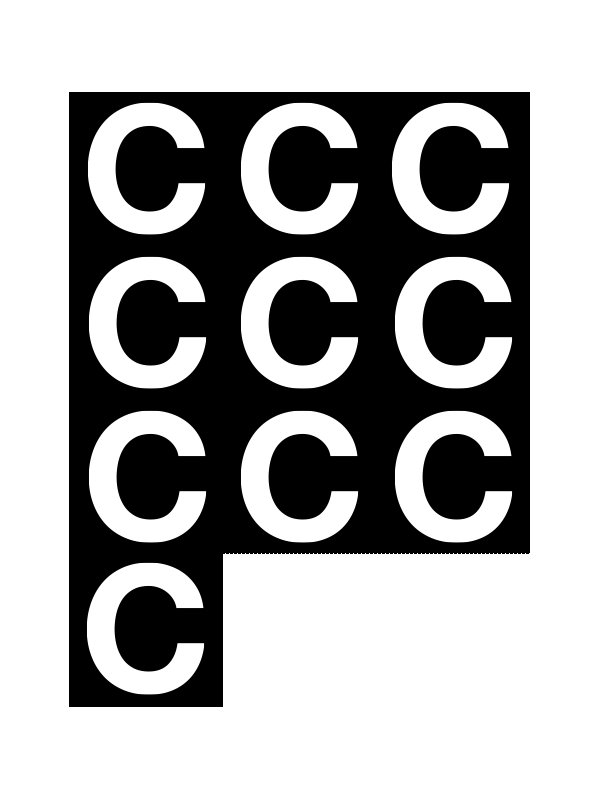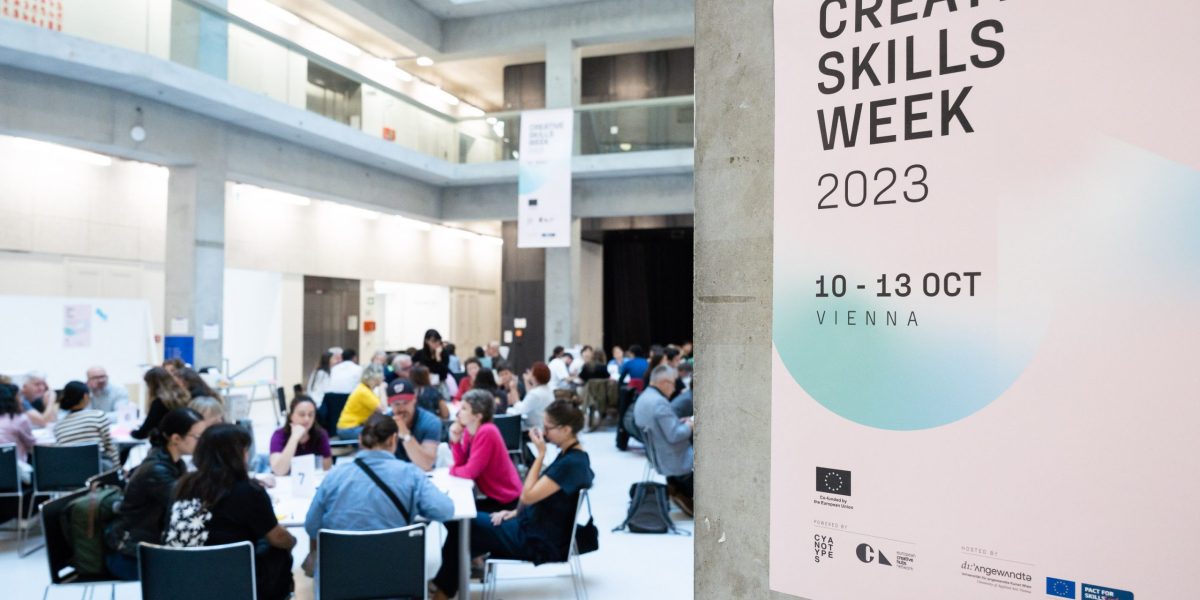
- December 20, 2023
- Matti Sturt-Scobie
Anticipating Creative Futures
Matthew Sturt-Scobie reports from Creative Skills Week 2023 and the first annual CYANOTYPES event: Anticipating Creative Futures.
This past October, after a year of research and development CYANOTYPES joined forces with key actors in the Cultural and Creative Sector Industries (CCSI) to present Creative Skills Week 2023 in Vienna with an illuminating programme titled Anticipating Creative Futures. The programme was a chance to celebrate all the community has accomplished and showcase its discoveries over this last year. This was a rigorous year, spent investigating the issue of skills gaps – between creatives and their industries’ needs – while anticipating the future skills they might need to face an uncertain world. At Vienna’s renowned University of Applied Arts, creatives and CCSI professionals gathered from across the continent, so that they might recalibrate their priorities to their urgencies.
This was the first of four annual CYANOTYPES events, where the public was invited to collaborate in analysing the projects’ findings to date. At this stage the consortium partners felt it crucial to platform the public’s perspective in analysing the outcomes of last year’s research tasks: an extensive literature review and industry survey. The event gathered thought leaders, cultural workers, educators, change-makers and dreamers from across Europe, creating a space where CYANOTYPES and its consortium partners could harness the power of group intelligence to shape the project’s direction. Their feedback is currently being analysed by the consortium partners, to incorporate it into the frameworks for education and curriculum development which will be piloted next year.
At this one-year milestone, the Anticipating Creative Futures programme was designed to explore innovative formats, exploring unconventional dynamics that serve the cross-pollination of ideas; group reflection and critique. Over the course of Creative Skills Week it was evident that a huge number of human connections were being made – an immense, as-of-yet unseen in scale gathering of Europe’s Creative Skills Community. Moving forward, the consortium greatly hopes this supportive network of cultural agents only strengthens and spreads. Here, I pause to take stock of my time in Vienna – to reflect on the vigorous thought exchange and provide a window into the project’s and its community’s hopes for the future.
Day 1 - Regroup
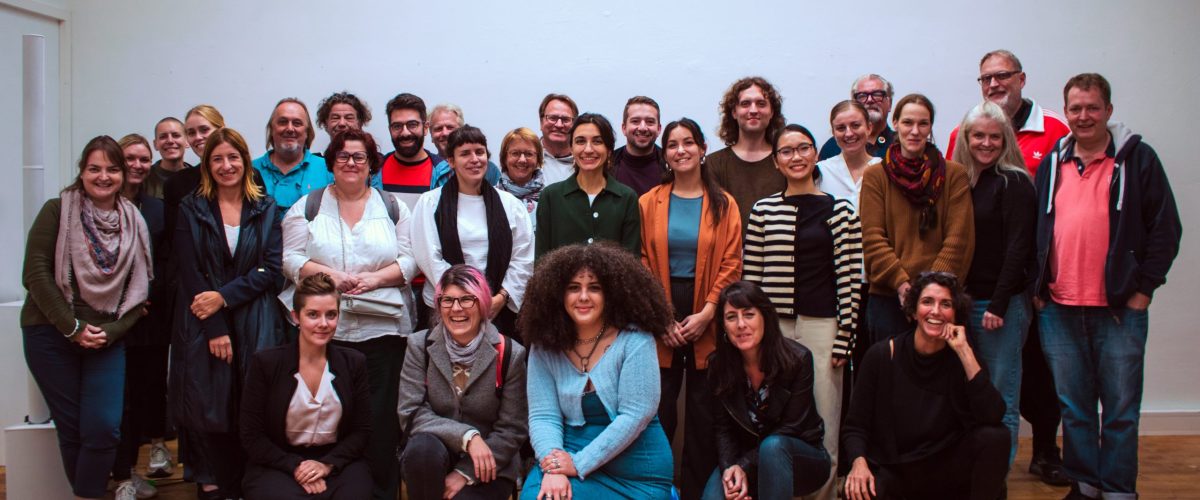
Before the main opening of Creatives Skills Week 2023, CYANOTYPES and its collaborators took a moment to regroup. In one of the University’s peripheral buildings, we sheltered from a grey, drizzly Vienna Autumn. For some, this was their first face to face meeting after a thousand Zoom sessions. Dotted around the room was an impressive roster of representatives – each member representing their wider networks: the EU Creative Pact for Skills, European Creative Hubs Network, European Institute for Innovation and technology; alongside them, industry sector organisations, market researchers, PhD students, writers and interns. Altogether, an eager, excited mélange – some in sharp suits, others, motley crew. The space provided felt appropriate: a studio for art students to play and experiment – here, we could communicate openly about process, progress and where to go next, without fear of failed experiments or leaving marks on the walls.
Once the projector was set up and everyone had taken their seats below tall, rain-tapped windows, the session began with a presentation on the extensive literature review and industry survey undertaken by MateraHub’s Becky Riches and her team, instrumental to our plans so far. This was a vast undertaking that can by no means be contained in one series of slides. Though, to summarise: using both human researchers and the aid of AI, we amassed and examined an immense body of literature appropriate to the project’s area of study. The presentation makes known some of the more interesting challenges to the research team’s pursuit of knowledge: from fragmentation between different regions of the industry, to the difficulties of data-collection in artistic fields. Difficult, because there are both frictions and overlaps in how actors identify their roles. Because of this, they had to discover means of creating quantifiers that could untangle disputes and overlaps in terminology: artist or designer? Architect or engineer? As well as all the various hybrids between them. In light of this, creating the investigative framework to analyse the industry was tough, but the pursuit nonetheless bore fruit.
Through the team’s research, we began to understand what qualities and skills the industry needs, so far unfulfilled. From here, it’s put to the room: which of these needs are most urgent? To answer this question, Florian Scheider, professor from the Norwegian University of Science and Technology takes the stage. Schneider is a key contributor to the European Institute of Innovation and technology; having met through CSW’s activity over the last year. Using this experience, his presentation becomes an informed and passionate call to involve artists, culture and creativity in the green transition. After all, he states “art is often the pursuit of affect, and CCSIs (culture and creative sector industries) are responsible for a large portion of global greenhouse gas emissions”. For its role in learning how to affect and be affected, he proposes that art will inevitably play an integral role in change making; art can be used to communicate and to empower individuals to turn feeling into action. To then answer the question of urgency, he asks “rather than finding out what is needed per sector [art, architecture, video game design etc.] why not find out what runs transversally throughout each?”.
Throughout the day, this term “Transversality”, became an important theme: rather than individual skills per se, reimagining learning altogether or “unlearning” was proposed as an alternative. How to learn better, how to be plastic, how to be responsive – these are all skills necessary to navigate an uncertain future. The industry landscape is changed so frequently by innovation and technology, at each juncture previously unimagined job-titles (“prompt-engineer” being one such example) seem to emerge – so might we be better prepared for the future ahead of us by inoculating students with these transversal competences? Moving on, the group discusses the challenges they are facing; it emerges that the greatest threat to our success is a lack of delegation or streamlining. Because of this, we agree that moving forward CYANOTYPES should try to develop some firmer structure, and a common language of terms that might help us communicate better.
At the tail end of discussion Esko Reinikainen, CYANOTYPES’ network and systems change consultant, introduces us to tomorrow’s conference formula. Rather than a speaker-audience relationship, it’s a stranger, more innovative approach. In Esko’s words “If you have never been to one of these workshops before, they’re going to sound weird”. Primed for the strangeness, the hope remaining is that tomorrow’s participants might help us answer some of today’s pertinent questions…
Day 2 - Slaying Sacred Cows


It’s 4pm, the tail end of a glorious day of crystalline autumn sunshine. Those who have travelled up from the south speak to today’s “winter chill”, whilst for those from the north this was a bright summer day – a testament to the geographical span of our audience.
As each of our participants filtered through the university’s walls, there was an interesting transition. At first, we’re met with classical, warmly romantic architecture. Then, as you enter the main atrium, the space inhales tall into a concertina of sharply angled, brightly lit towering walls of white, glass and concrete. This architecture strongly exudes a sense of the long-standing, evolving learning institution it houses.
Once all had their lanyards around necks and complimentary beverages in hand, a light static of conversation forms – introductions and information signals spread across the halls. After a time, optimistic that this is precisely the energy we had hoped for, we guided this electricity to the main lecture hall. Here, we begin the process of introducing everyone to the framework of the day and harnessing this vibrancy.
Taking our seats, we’re welcomed with a rousing performance by “V.O.I.C.E” a local contemporary pop and jazz choir, dressed in glimmering black and silver. Then, a quick introduction to the project, a sharing of thanks to our collaborators. Following this, we’re introduced to Barbara Stacher, who is the senior expert at the European Commission’s Directorate-General for education and culture. Stacher, introduces us to the EU’s renewed focus on the creative industries. We are guided to an immense body of resources, both educational and financial opportunities funded by the European Union. Their supporting efforts are increasingly apparent: to the EU, the creative industries provide immense economic “spillover” into other areas of the economy, they are essential drivers of imagination and change and they are worth protecting with policy focus and investment. Following this bounty of direction and resources for artists, Tânia Almeida Santos introduces us to the why of it all and our plans for the project moving forward.
Santos represents the European Creative Hubs Network – here, she reminds us that a healthy system of education and job opportunities are instrumental in talent-retention for both urban and rural areas. As partners in the CYANOTYPES project, they play a key role in creating the pilot programmes we are developing, the “proof of practice” so to say. As they speak, their words re-frame for us creative education and the creative industries as (much like today’s activities) a place to play, socialise and learn informally. They emphasise that here, the community is the curriculum, today’s goal: to explore new structures to harness the group and disseminate new knowledge, to pluralistically construct blueprints for creative education moving forward. After catching up the audience with CYANOTYPES’s work so far, our concerns we have in terms of “skills gaps” in the industry, Florian Scheider presents a persuasive case for art’s importance in a shifting world. Then, Esko Reinikainen introduces us to our novel conference format.
The format is designed to stimulate interaction between unlikely agents and amass as much feedback as possible. In pursuit of collective intelligence, we invited people to create small groups, with the instruction to choose people whom they would not naturally gravitate towards. After some trepidatious meandering, our chimerical groups of ages, backgrounds and industries were set. Following this they each offered today’s series of questions:
Who decides what an artist is?
How would you design this conference to fail?
And, what are the job profiles of the future?
In conjunction with these queries they were provided post-it notes and three walls with different functions wherein we could collect, en masse, their sticky-note perspectives. Participants were asked to record everything, documentation being our greatest tool to then reflect and recalibrate. The first wall titled “the wall of pain” was to capture moments of disagreement, of friction between participants. On the second: “The tower of babel”, participants could state what they have so far not understood; whether something was vague or obscure. Lastly, the “occupational profiles” wall, on which our groups could imagine, predict or fantasise about what the jobs of the future might be. We call this session “slaying sacred cows” not only because it is our prerogative to open ourselves up to criticism: where might we be going wrong? But also, to question the “sacred” systems that have defined education so far: is university the key to creative success?
Wandering through this hive of information exchange, you catch key moments of synergy and tension. Some, potential seeds for future collaboration where people have seen eye-to-eye on certain ambitions or ideologies. We see these smaller webs facilitate inflection points between actors that may never have met – a Dutch representative from the New European Bauhaus movement, knocks heads with a ceramicist. A fashion industry consultant meets a cultural hub facilitator from Manchester. From this dialogue, each participant is granted new perspectives and industry insights; how do these spaces function? How do I operate within them successfully? Could I offer insight to this person’s project?

Amongst the bustle, you catch fragments of debate on the role of social media – hearts and likes – in career success, whether or not this is the model we should capitulate to or imagine something altogether different? We see lively discussion on the role of art in society, people recommending books and learning resources, whilst in the background a business card slides across the table. One line in a conversation caught our eye: “an artist is defined by a hundred spatiotemporal frameworks, it’s ideological, its local”. This resonated, as in seeking to help artists, we need to know who they are. Each of these discussions eventually grew into a textured, neon patina on each of the boards. This information collage, we will later analyse to form the framework for future actions.
As the day draws to a close, our wonderful production team shepherds this newly minted community to Kassenhalle. In this space, somewhere between baroque ball-room and jardin-botanique, we unite around food and wine, a space to let all of today’s happenings percolate into unique new world-views. This became a moment to rest and refuel for tomorrow’s “world café”, where each participant is granted the opportunity to host their own “mini-conference”.
Day 3 - World Café

With a slightly earlier start to the day, the first conversations grew from huddles around the complimentary coffee. Stimulated following yesterday’s dynamic, unstructured learning sessions, today we gathered around particular issues.
Today, if a participant had been particularly moved by one of yesterday’s topics, or brought their own external concerns – whomever had the nerve to stand amongst this throng of impassioned creatives was welcomed to propose a conference topic. Thankfully, within moments of introducing the concept, several took to the stand, whole-heartedly welcoming others to gather around their particular interests. One candidate, from the UK stood to offer their experience in making local creative hubs – spaces for creatives to work affordably and form community. Another, Charlotte Gimfalk from Sweden’s Screen Skills Committee (also a speaker during CSW), offers us the space to unpack her innovative pursuits in creating new ways to learn and qualify for the diverse body of practical skills needed to operate in the film industry.
Once the topics were decided upon, the crowd spread throughout the university and congregated in smaller nests. There were but a few rules: the conference guide is not a leader, but a facilitator; if ever the conversation does not serve you, you are welcome to leave and should do so without fear of judgement; lastly, engage with others with understanding, not convincing in mind. This light structure facilitated a free flow of currents, respectfully engaging and disengaging. During the session, one might begin with particularly peaked interest for the title of a conference. Then, sensing you might have shared all you have to share, or learnt all you needed to learn, you could freely migrate to another conference that better suits your emerging, shifting curiosities.
As you flitted from one space to the next, you witnessed dreamy ambitions and circuitous tales of how practitioners got to where they are today. In one space, we were relayed the logistics of seeking out funding for a particular project you might have in mind. In others, we are reminded of the importance of mutability and flexibility in response to a changing industrial landscape. Change here is a theme apparent throughout. In one conference, a Belgian professional working in music publication, describes the loss of intermediaries in the music industry. He describes how creators have direct access to their audience, and publication can be done independently as a result of new technology. In Anticipating Creative Futures we must have these technology-driven, accelerating innovations in mind. The topology is changing, all of us here might not recognise the world we wake up in tomorrow.
Like yesterday, we wrote down, photographed, filmed – with the aim of documenting as much as we could from the information that emerged. After a year of working together under the public radar – this time in the light was immensely rewarding. By the end of the day, our walls were stacked with thousands of neon reflections from participants – their generosity of expertise was unparalleled. Industry actors brought their concerns, and artists brought their struggles. Altogether, a vivid picture of the public’s (not only) professional but personal relationship with their crafts emerged – working together we hope to break new, equitable ground that serves both interests.
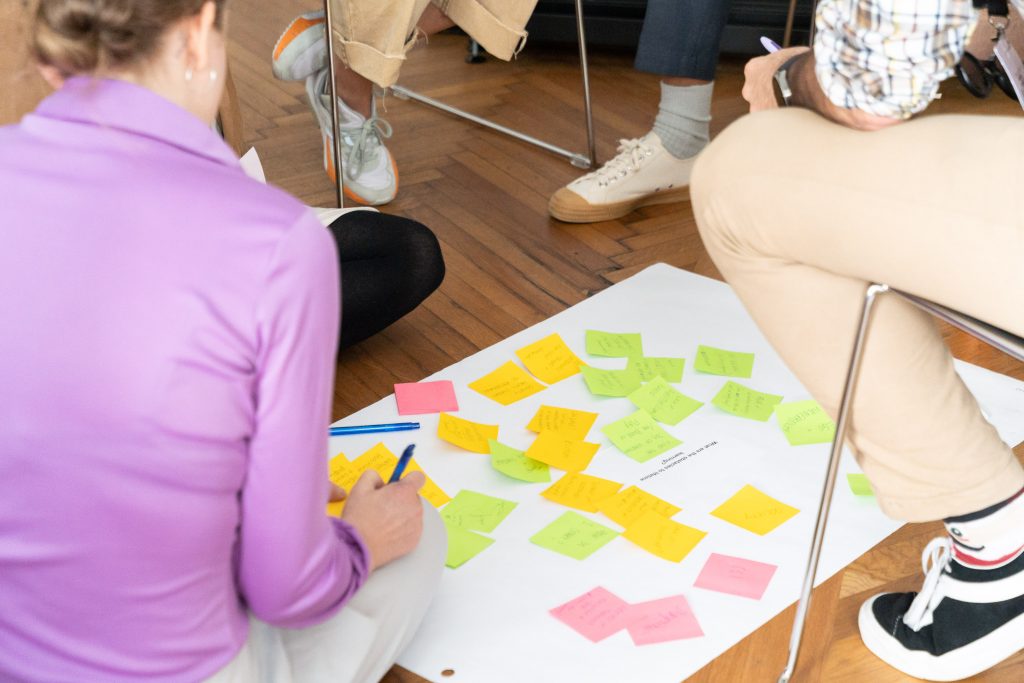
What Does our Future Hold?
As the day draws to a close, we give our thanks to all who participated. Over the 3 days, we fertilised a huge network of newly introduced creatives and industry leaders, visibly now, connected and comfortable, together in this space of learning.
It’s worth noting that in bringing these hundreds of minds together, we opened ourselves up to frictions. For a project dedicated to an industry that spans so many lives and borders, this was our duty. We are operating in a fractal community that spans everyone from tech CEO’s and art students, to art collectives and documentary film makers. In light of this, communication, understanding and solidarity became key terms in how we might overcome the “poly-crisis” we now live in. In this age of AI, climate change and international conflict, it was refreshing and necessary to see so much collaboration as we carve out a contract with the future. These concerns, we will be exploring ways to mitigate and adapt to in our pilot programs.
At points throughout our time, we were also made aware of this iteration’s limitations. In trying to create a universal and appealing language, some people were lost in terminology. Looking forward, we want to learn to communicate in a way where access is as equal as we can make it. Next year we would like to foster a much more diverse network, of more age and race representation. If we can do that, this already potent formula for thought-exchange would soar to even higher heights – serving the whole breadth of the community we hope to sustain. As we step out of the afterglow of this immense exchange we’ll be wholeheartedly delving into all the knowledge that emerged. Over these next months, we hit the ground running – harnessing this knowledge for our pilot programs, employing it in on-the-ground frameworks for future-proof creative learning.
By Matthew Stuart-Scobie
